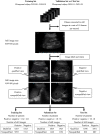Deep Learning Assisted Detection of Abdominal Free Fluid in Morison's Pouch During Focused Assessment With Sonography in Trauma
- PMID: 34631730
- PMCID: PMC8494971
- DOI: 10.3389/fmed.2021.707437
Deep Learning Assisted Detection of Abdominal Free Fluid in Morison's Pouch During Focused Assessment With Sonography in Trauma
Abstract
Background: The use of focused assessment with sonography in trauma (FAST) enables clinicians to rapidly screen for injury at the bedsides of patients. Pre-hospital FAST improves diagnostic accuracy and streamlines patient care, leading to dispositions to appropriate treatment centers. In this study, we determine the accuracy of artificial intelligence model-assisted free-fluid detection in FAST examinations, and subsequently establish an automated feedback system, which can help inexperienced sonographers improve their interpretation ability and image acquisition skills. Methods: This is a single-center study of patients admitted to the emergency room from January 2020 to March 2021. We collected 324 patient records for the training model, 36 patient records for validation, and another 36 patient records for testing. We balanced positive and negative Morison's pouch free-fluid detection groups in a 1:1 ratio. The deep learning (DL) model Residual Networks 50-Version 2 (ResNet50-V2) was used for training and validation. Results: The accuracy, sensitivity, and specificity of the model performance for ascites prediction were 0.961, 0.976, and 0.947, respectively, in the validation set and 0.967, 0.985, and 0.913, respectively, in the test set. Regarding feedback prediction, the model correctly classified qualified and non-qualified images with an accuracy of 0.941 in both the validation and test sets. Conclusions: The DL algorithm in ResNet50-V2 is able to detect free fluid in Morison's pouch with high accuracy. The automated feedback and instruction system could help inexperienced sonographers improve their interpretation ability and image acquisition skills.
Keywords: FAST; Morison pouch; ascites; deep learning; hemoperitoneum; trauma.
Copyright © 2021 Cheng, Chiu, Hsu, Pan, Tsai and Lin.
Conflict of interest statement
The authors declare that the research was conducted in the absence of any commercial or financial relationships that could be construed as a potential conflict of interest.
Figures
Similar articles
-
Free fluid in Morison's pouch on bedside ultrasound predicts need for operative intervention in suspected ectopic pregnancy.Acad Emerg Med. 2007 Aug;14(8):755-8. doi: 10.1197/j.aem.2007.04.010. Epub 2007 Jun 6. Acad Emerg Med. 2007. PMID: 17554008
-
Using Deep Learning to Detect the Presence and Location of Hemoperitoneum on the Focused Assessment with Sonography in Trauma (FAST) Examination in Adults.J Digit Imaging. 2023 Oct;36(5):2035-2050. doi: 10.1007/s10278-023-00845-6. Epub 2023 Jun 7. J Digit Imaging. 2023. PMID: 37286904 Free PMC article.
-
Caudal Edge of the Liver in the Right Upper Quadrant (RUQ) View Is the Most Sensitive Area for Free Fluid on the FAST Exam.West J Emerg Med. 2017 Feb;18(2):270-280. doi: 10.5811/westjem.2016.11.30435. Epub 2017 Jan 19. West J Emerg Med. 2017. PMID: 28210364 Free PMC article.
-
Morison's pouch: anatomical review and evaluation of pathologies and disease spread on cross-sectional imaging.Abdom Radiol (NY). 2020 Aug;45(8):2315-2326. doi: 10.1007/s00261-020-02597-1. Abdom Radiol (NY). 2020. PMID: 32529262 Review.
-
Focused abdominal sonogram for trauma: the learning curve of nonradiologist clinicians in detecting hemoperitoneum.J Trauma. 1999 Apr;46(4):553-62; discussion 562-4. doi: 10.1097/00005373-199904000-00003. J Trauma. 1999. PMID: 10217217 Review.
Cited by
-
Prospective clinical evaluation of deep learning for ultrasonographic screening of abdominal aortic aneurysms.NPJ Digit Med. 2024 Oct 15;7(1):282. doi: 10.1038/s41746-024-01269-4. NPJ Digit Med. 2024. PMID: 39406888 Free PMC article. Review.
-
Automated detection and segmentation of pleural effusion on ultrasound images using an Attention U-net.J Appl Clin Med Phys. 2024 Jan;25(1):e14231. doi: 10.1002/acm2.14231. Epub 2023 Dec 13. J Appl Clin Med Phys. 2024. PMID: 38088928 Free PMC article.
-
Physician Versus Large Language Model Chatbot Responses to Web-Based Questions From Autistic Patients in Chinese: Cross-Sectional Comparative Analysis.J Med Internet Res. 2024 Apr 30;26:e54706. doi: 10.2196/54706. J Med Internet Res. 2024. PMID: 38687566 Free PMC article.
-
Artificial intelligence for abdominopelvic trauma imaging: trends, gaps, and future directions.Abdom Radiol (NY). 2025 Mar 21:10.1007/s00261-025-04816-z. doi: 10.1007/s00261-025-04816-z. Online ahead of print. Abdom Radiol (NY). 2025. PMID: 40116889 Free PMC article. Review.
-
Artificial Intelligence in Emergency Radiology: Where Are We Going?Diagnostics (Basel). 2022 Dec 19;12(12):3223. doi: 10.3390/diagnostics12123223. Diagnostics (Basel). 2022. PMID: 36553230 Free PMC article. Review.
References
-
- Melniker LA, Leibner E, McKenney MG, Lopez P, Briggs WM, Mancuso CA. Randomized controlled clinical trial of point-of-care, limited ultrasonography for trauma in the emergency department: the first sonography outcomes assessment program trial. Ann Emerg Med. (2006) 48:227–35. 10.1016/j.annemergmed.2006.01.008 - DOI - PubMed
-
- Centers for Disease Control and Prevention . National Center for Injury Prevention and Control. Available online at: https://wisqars-viz.cdc.gov:8006/explore-data/home. (accessed June 27, 2021).
LinkOut - more resources
Full Text Sources



